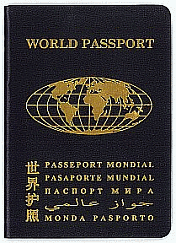
The mandate for the WORLD PASSPORT is Article 13(2) of the Universal Declaration of Human Rights:
Everyone has the right to leave any country, including one’s own, and to return to one’s country.
The World Passport is a 30 page Machine Readable Travel Document (MRTD*) with alphanumeric code line, scanned-in passport photo and “ghost” security paper with embedded logo, the data page laminated, in 7 languages:
English, French, Spanish, Russian, Arabic, Chinese and Esperanto.
Each passport is numbered and each page contains the World Citizen logo as background. Two pages are reserved for affiliate identifications: diplomatic corps, organizations, firms, etc. There are nineteen visa pages. In the inside back cover, there is space for home address, next of kin, doctor, employer, driving license no. and national passport/identity number. The cover is blue with gold lettering.
For nation-state recognition, please go to Documents / Visas.
To apply for a World Passport, please go to the online form at Online Application Form or use the printable form (to send by mail or email) at World Passport Application Form
The World Passport represents the inalienable human right of freedom of travel on planet Earth. Therefore it is premised on the fundamental oneness or unity of the human community.
In modern times, the passport has become a symbol of national sovereignty and control by each nation-state. That control works both for citizens within a nation and all others outside. All nations thus collude in the system of control of travel rather than its freedom. If freedom of travel is one of the essential marks of the liberated human being, as stated in the Universal Declaration of Human Rights, then the very acceptance of a national passport is the mark of the slave, serf or subject. The World Passport is therefore a meaningful symbol and sometimes powerful tool for the implementation of the fundamental human right of freedom of travel. By its very existence it challenges the exclusive assumption of sovereignty of the nation-state system. It is designed however to conform to nation-state requirements for travel documents. It does not, however, indicate the nationality of its bearer, only his/her birthplace. It is therefore a neutral, apolitical document of identity and potential travel document.
A passport gains credibility only by its acceptance by authorities other than the issuing agent. The World Passport in this respect has a track record of over 60 years acceptance since it was first issued. Today over 185 countries have visaed it on a case-by-case basis. In short, the World Passport represents the one world we all live in and on. No one has the right to tell you you can’t move freely on your natural birthplace! So don’t leave home without one!
Return to the World Government Documents.


